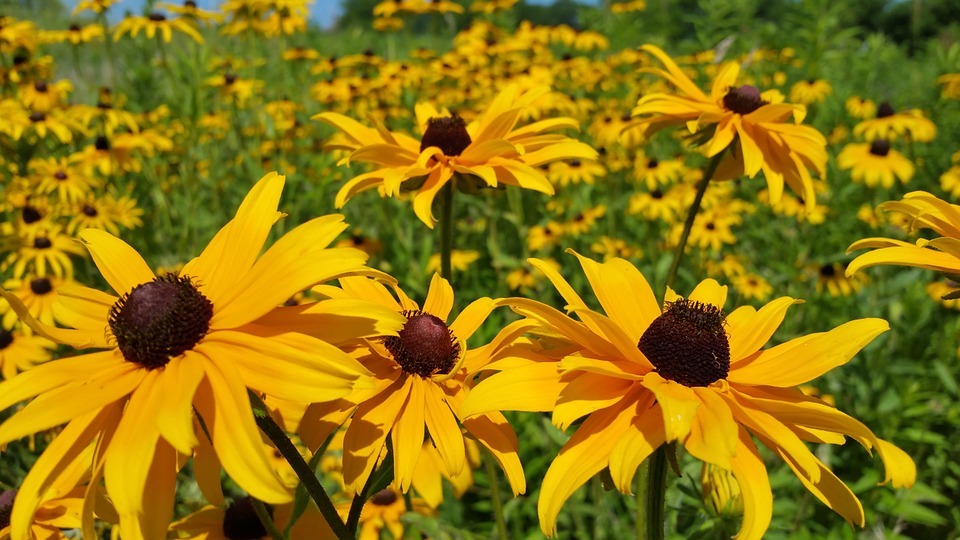Probably most people have seen a black-eyed Susan plant before. This pretty plant that has vibrant yellow petals are common wildflowers that is native to North America where can be found growing in fields, gardens, and countrysides. They are also easily recognized because they have a distinct dark brown center along with bright yellow colored daisy-like petals. Aside from that, they also have hairy foliage.
Black-eyed Susans look excellent in a wildflower meadow or a garden. This is because their presence adds bright color and charm to where it is planted. Gardeners love planting black-eyed Susans because they are so easy to plant, grow, they need low maintenance care, plus, they are quick growing. If you are going to ask us, they are the perfect flowers to grow if you are a beginner. Aside from all that, black-eyed Susans are also drought and heat resistant, which makes them ideal for hot, dry climates. In fact, when it comes to growing this perennial flower, all you would have to do is sow its seeds and leave nature do its thing. Black-eyed Susans also thrive well in almost soil conditions, just as long as it’s always well-drained. And to top it all off, these vibrant and cheerful flowers can reseed after the first season, which means that you can make sure that you can have pretty flowers in your garden the next year without having to replant!
Black-eyed Susans blooms productively during early summer and early fall. Take note that you have to give them enough space to grow because they tend to spread, and they can crowd out other flowers that are in your garden. In fact, it becomes so quickly that they have been identified as a weed in some places.
As a bonus, black-eyed Susans are excellent cut flowers because they can attract bees and butterflies to the garden. They are also a source of food for some small animals
Facts About Black-Eyed Susan
- Black-eyed Susan has erect, multi-branched stems that can grow from 12 to 39 inches in height. It also has robust stems that are covered with stiff hairs.
- Black-eyed Susan has oblong and elliptical leaves that look like a rosette during its first year of growth. These leaves can sometimes be smooth or have toothed edges. Plus, it also has a rough texture.
- Black-eyed Susan can produce a sizeable solitary flower head on top of its flowering stalk. The said flower head is made up of 8 to 21 bright yellow-orange ray florets on the periphery, and it has dark brown disk florets in the center.
- Black-eyed Susan produces flowers that have both types of reproductive organs, which means they are perfect flowers.
- Black-eyed Susan typically blooms from June to September. Its flowers can attract butterflies and bees, which are its primary pollinators.
- The fruit of a black-eyed Susan is called a brown achene, which is a type of dry fruit. Black-eyed Susan can produce a handful of this small black seed.
- Black-eyed Susan spreads via its seed.
- Black-eyed Susan also acts as one of the vital source of shelter and food for many birds and animals such as rabbits, deer, and slugs, they all like to eat this plant.
- The Black-eyed Susan’s scientific name is “Rudbeckia,” this is in honor of OlausRudbeck, who is a well-known Swedish botanist.
- Black-eyed Susan is also called “gloriosa daisy” because it blooms daisy-like flowers that can also come in various shades of golden, orange color, and yellow.
- Black-eyed Susan can be cultivated in order to prevent erosion of the soil.
- “Toto,” “Double Gold,” “Indian Summer,” are just some of the black-eyed Susan that is commonly cultivated in gardens. Black-eyed Susan can be also be cut flowers for making different bouquets, and it can last on your vase for over ten days.
- Since April 18th, 1918, Black-eyed Susan is the state flower of Maryland.
- Native Americans used black-eyed Susan to treat snake bites, common cold, flu, various infections, earache, and swelling.
- Black-eyed Susan represents inspiration and righteousness in the language of flowers.

